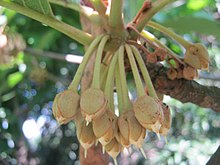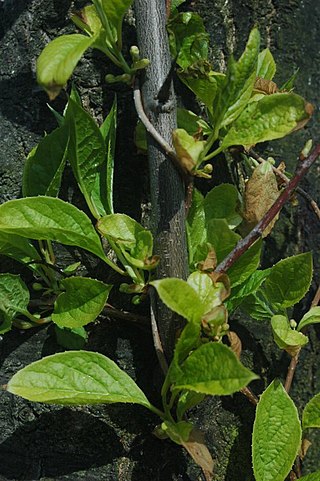
Schisandra, the magnolia vines, is a genus of twining shrubs that generally climb on other vegetation. Various authors have included the plants in the Illiciaceae

Tipularia is a genus of temperate terrestrial orchids. As of June 2014, there are seven recognized species, native to Asia and North America.
- Tipularia cunninghamii(King & Prain) S.C.Chen, S.W.Gale & P.J.Cribb - Uttarakhand, Sikkim, Taiwan
- Tipularia discolor(Pursh) Nutt. - from Texas and Florida north to Michigan and Massachusetts
- Tipularia harae(Maek.) S.C.Chen - Kyushu
- Tipularia japonicaMatsum. - Japan, Korea
- Tipularia josephiRchb.f. ex Lindl. - Tibet, Nepal, Bhutan, Assam, Myanmar
- Tipularia odorataFukuy. - Taiwan
- Tipularia szechuanicaSchltr. - Gansu, Shaanxi, Sichuan, Yunnan

Paris is a genus of flowering plants described by Linnaeus in 1753. It is widespread across Europe and Asia, with a center of diversity in China.
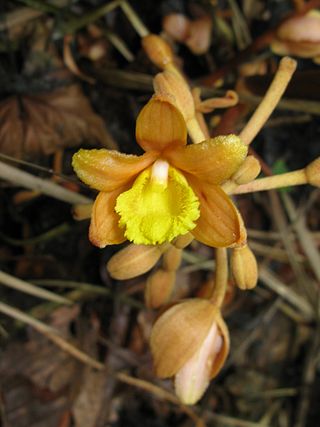
Galeola is a genus of orchids belonging to the subfamily Vanilloideae.

Odontochilus is a small genus from the orchid family (Orchidaceae). These terrestrial, mycoparasitic orchids occur from China, Japan, the Himalayas, Southeast Asia, New Guinea and Melanesia. The genus is related to Gonatostylis, endemic to New Caledonia.

Aletris, the colicroot, colicweed, crow corn, or unicorn root, is a genus of flowering plants in the family Nartheciaceae, native to North America and to eastern and southeastern Asia, especially China. It was used as a component in Lydia Pinkham's original Vegetable Compound.

Plectocomia is a genus of flowering plant in the family Arecaceae native to China, the Himalayas, and Southeast Asia. Plants are dioecious, with male and female flowers produced on separate individuals.

Eulalia is a genus of Asian, African, and Australian plants in the grass family.

Pholidota, commonly known as rattlesnake orchids, is a genus of flowering plants from the orchid family, Orchidaceae. Plants in this genus are clump-forming epiphytes or lithophytes with pseudobulbs, each with a single large leaf and a large number of small, whitish flowers arranged in two ranks along a thin, wiry flowering stem that emerges from the top of the pseudobulb. There are about thirty five species native to areas from tropical and subtropical Asia to the southwestern Pacific.
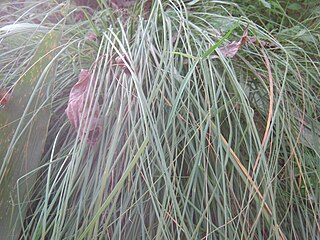
Eulaliopsis is a genus of Asian plants in the grass family.

Dendrobium heterocarpum, commonly known as 尖刀唇石斛 , is a species of orchid that is native to the China, Nepal, Bhutan, Assam, the Indian subcontinent and Southeast Asia.

Dendrobium moschatum, the musky-smelling dendrobium, is a species of orchid. It is native to the Himalayas, and Indochina.

Gastrochilus affinis is a species of orchid. It is native to Yunnan, Nepal, Assam, Bhutan and Sikkim.
Cyathopus is a genus of Himalayan plants in the grass family. The only known species is Cyathopus sikkimensis, native to the mountains of Bhutan, Yunnan, Sikkim, Nepal, Uttarakhand, and nearby regions.

Notholirion is a small Asian genus of bulbous plants in the lily family, Liliaceae. It is closely related to Lilium, but each individual flowers only once, and then dies after producing offsets. The bulb is covered by a tunic. Leaves are basal, produced in autumn and winter.
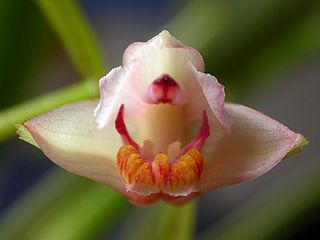
Cryptochilus is a genus of flowering plants from the orchid family, Orchidaceae. Its species are native to China, the Himalayas, and Indochina.

Uncifera is a genus of epiphytic flowering plants from the orchid family, Orchidaceae. It is native to the Himalayas and to Indochina.

Tupistra is a genus of about 20 species of flowering plants found in south Asia, from southern China to Sumatra and Ambon Island. In the APG III classification system, it is placed in the family Asparagaceae, subfamily Nolinoideae.
Aulandra is a genus of plant in the family Sapotaceae endemic to Borneo. As of September 2013 the World Checklist of Selected Plant Families recognises 3 species:

Clintonia udensis is a species of flowering plant in the lily family Liliaceae. It is the only species of Clintonia native to Asia. It prefers sparsely forested habitat including the alpine forests of the Himalayas.
